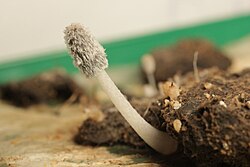Coprinopsis radiata
Topic: Biology
 From HandWiki - Reading time: 2 min
From HandWiki - Reading time: 2 min
| Coprinopsis radiata | |
|---|---|

| |
| Scientific classification | |
| Domain: | Eukaryota |
| Kingdom: | Fungi |
| Division: | Basidiomycota |
| Class: | Agaricomycetes |
| Order: | Agaricales |
| Family: | Psathyrellaceae |
| Genus: | Coprinopsis |
| Species: | C. radiata
|
| Binomial name | |
| Coprinopsis radiata (Bolton) Redhead, Vilgalys & Moncalvo (2001)
| |
| Synonyms[1] | |
| |
Coprinopsis radiata, formerly known as Coprinus radiatus, and commonly known as the miniature woolly inky cap,[2] is a coprophilous fungus that grows on herbivore dung. It is heterothallic.
Taxonomy
Coprinopsis radiata was originally published in 1788 as Agaricus radiatus by English naturalist James Bolton. Samuel Frederick Gray transferred it to Coprinus in his 1821 work A Natural Arrangement of British Plants. In 2001, the genus Coprinus was reorganized and this species was moved to the newly created genus Coprinopsis.[3]
Ecology
Coprinopsis radiata is known to grow from the dung of donkeys, sheep and horses.[4]
Morphology
After mating and dikaryotic fruiting, the initial fruit body (young) is narrow egg-shaped and white. The mature fruit body is bluish-grey.[5][6][7]
Research
Coprinopsis radiata has been used as a model organism to study basidiospore formation.[8]
Culture conditions
Coprinopsis radiata is successfully cultured on horse dung at room temperature; under these conditions (with no control of external everyday light) the fungus can form a mushroom (mature fruit body).[8]
Basidiospore activation
Coprinopsis radiata produces basidiospores from its fruit body that, under proper conditions, will germinate. Spores are activated by specific chemicals or temperatures that may act synergistically. Chemically, those resembling heterocyclic, unsaturated rings with or without small side groups, such as furfural, activate spores. Salt also causes slight activation. In the study, only low concentrations of chemicals were needed for activation. In nature, it is postulated that the combination of the following can lead to activation of dormant spores: temperature from the animal, dung heat (active organisms produce heat) and furans found on the dung (basis of compounds like furfural).[8]
| Coprinopsis radiata | |
|---|---|
| Mycological characteristics | |
| gills on hymenium | |
| cap is ovate or flat | |
| hymenium is free | |
| stipe is bare | |
| spore print is black | |
| ecology is saprotrophic | |
| edibility: unknown | |
See also
References
- ↑ "GSD Species Synonymy: Coprinopsis radiata (Bolton) Redhead, Vilgalys & Moncalvo". Species Fungorum. CAB International. http://www.speciesfungorum.org/GSD/GSDspecies.asp?RecordID=474190.
- ↑ Arora, David (1986). Mushrooms demystified: a comprehensive guide to the fleshy fungi (Second ed.). Berkeley: Ten Speed Press. ISBN 978-0-89815-169-5.
- ↑ "Coprinus Pers. and the disposition of Coprinus species sensu lato". Taxon 50 (1): 203–41. 2001. doi:10.2307/1224525.
- ↑ Richardson, Michael J. (2008). "Coprophilous fungi from the Greek Aegean islands". Mycologia Balcanica 5: 23–32. http://www.mycobiota.com/mycobalcan_pdf/0504_Richardson.pdf.
- ↑ Moore, David. "Molecular genetic aspects of fungal developmental biology". http://www.davidmoore.org.uk/Biog_01-10.htm.
- ↑ "Coprinopsis radiata - NatureSpot". http://www.naturespot.org.uk/species/coprinopsis-radiata.
- ↑ Stevens, Michael Wood & Fred. "California Fungi: Coprinopsis radiata". http://www.mykoweb.com/CAF/species/Coprinopsis_radiata.html.
- ↑ 8.0 8.1 8.2 "Factors influencing the germination of basidiospores of Coprinus radiatus". Journal of General Microbiology 77 (2): 393–401. 1973. doi:10.1099/00221287-77-2-393. http://mic.sgmjournals.org/content/77/2/393.full.pdf.
External links
Wikidata ☰ Q10477885 entry
 |
 KSF
KSF